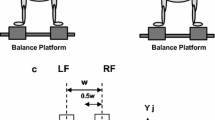Summary
-
1.
Goldfish were deprived of visual input and/or normally functional horizontal semicircular canals.
-
2.
Their horizontal eye movements were measured from cinematographic records, and the extent to which the eyes compensated for horizontal rotations of the head was given by the “compensation factor,” CF, the ratio (rotation of the eyes relative to the head)/(rotation of the head). All data were obtained from freely-swimming fish.
-
3.
The CF's for normal, canal-lesioned, blinded, and blinded/canal-lesioned animals were: −0.95±0.10, −0.80±0.10, −0.50±0.04, and −0.41±0.06 (means ±2 S.E.M.), respectively.
-
4.
These figures lead to the conclusion that the visual input contributes −0.39 to −0.45 to the CF, while the canal input contributes only −0.09 to −0.17. Thus, the visual input is the major factor; the canals are quantitatively much less important. There is in addition a third source (or sources) contributing to the CF, since the blinded/canal-lesioned fish compensated partially.
-
5.
Experiments of partially restrained animals showed that this third source is not a preprogrammed instruction, nor is it dependent on sensory feedback from the rest of the labyrinth, tactile receptors, lateral line current detectors, or proprioceptors in the trunk. Its identity remains a mystery.
Similar content being viewed by others
References
Benjamins, C. E.: Contribution à la connaissance des réflexes toniques des muscles de l'oeil. Archs. néerl. Physiol.2, 536–544 (1918)
Biederman-Thorson, M., Thorson, J.: Rotation-compensating reflexes independent of the labyrinth: neuromuscular correlates in the pigeon. J. comp. Physiol.83, 103–122 (1973)
Bizzi, E., Kalil, R. E., Tagliasco, V.: Eye-head coordination in monkeys: evidence for centrally patterned organization. Science173, 452–454 (1971)
Collewijn, H.: Optokinetic eye movements in the rabbit: input-output relations. Vision Res.9, 117–132 (1969)
Delius, J. E., Vollrath, F. W.: Rotation compensating reflexes independent of the labyrinth: neurosensory correlates in pigeons. J. comp. Physiol.83, 123–124 (1973)
Dijkgraaf, S.: Die Augenstielbewegungen der Languste (Panulirus vulgaris). Experientia (Basel)11, 329–330 (1955)
Dijkgraaf, S.: Über die kompensatorischen Augenstielbewegungen bei Brachyuren. Pubbl. Staz. Zool. Napoli28, 341–358 (1956)
Dijkgraaf, S.: The functioning and significance of the lateral-line organs. Biol. Rev.38, 51–105 (1963)
Easter, S. S.: Spontaneous eye movements in restrained goldfish. Vision Res.11, 333–342 (1971)
Easter, S. S.: Pursuit eye movements in goldfish (Carassius auratus). Vision Res.12, 673–688 (1972a)
Easter, S. S.: Optokinetic nystagmus in goldfish. Soc. Neurosci. Abstracts2, 212 (1972b)
Easter, S. S., Johns, P. R., Heckenlively, D.: Horizontal compensatory eye movements in goldfish (Carassius auratus). I. The normal animal. J. comp. Physiol.92, 23–35 (1974)
Evoy, W. H., Cohen, M. J.: Central and peripheral control of arthropod movements. Advance comp. Physiol. Biochem.4, 225–266 (1971)
Harden-Jones, F. R.: The reaction of fish to moving backgrounds. J. exp. Biol.40, 437–446 (1963)
Harris, A. J.: Eye movements of the dogfishSqualus acanthias L. J. exp. Biol.43, 107–130 (1965)
Hermann, H. T., Constantine, M.: Eye movements in the goldfish. Vision Res.11, 313–333 (1971)
Horridge, G. A.: Study of a system, as illustrated by the Optokinetic response. In: S.E.B. Symp.20, Nervous and hormonal mechanisms of integration, p. 179–197 (1966)
Lowenstein, O.: The tonic function of the horizontal semicircular canals in fishes. J. exp. Biol.14, 473–482 (1937)
Lowenstein, O.: The labyrinth. In: Fish Physiology, Vol. V, 207–241 (ed. Hoar, W. D., and D. J. Randall). New York: Academic Press 1971
Lowenstein, O., Sand, A.: The individual and integrated activity of the semicircular canals of the elasmobranch labyrinth. J. Physiol. (Lond.)99, 89–101 (1940)
Lyon, E. P.: A contribution to the comparative physiology of compensatory motions. Amer. J. Physiol.3, 86–114 (1899)
Lyon, E. P.: Compensatory motions in fishes. Amer. J. Physiol.4, 77–82 (1900)
Roberts, B. L.: Activity of lateral-line sense organs in swimming dogfish. J. exp. Biol.56, 105–118 (1972)
Robinson, D. A.: Eye movement control in primates. Science161, 1219–1224 (1968)
Skavenski, A. A., Robinson, D. A.: Role of abducens neurons in vestibuloocular reflex. J. Neurophysiol.36, 724–738 (1973)
Szentágothai, J.: The elementary vestibulo-ocular reflex arc. J. Neurophysiol.13, 395–407 (1950)
Ter Braak, J. W. G.: Untersuchungen über optokinetischen Nystagmus. Arch. néerl. Physiol.21, 309–376 (1936)
Traill, A. B., Mark, R. F.: Optic and static contributions to ocular counterrotation in carp. J. exp. Biol.52, 109–124 (1970)
Trevarthen, C.: Vision in fish: the origins of the visual frame of action in vertebrates. In: The central nervous system and fish behavior (ed. D. Ingle), p. 61–96. Chicago: Chicago University Press 1968
Walls, G. L.: The evolutionary history of eye movements. Vision Res.2, 69–80 (1962)
Zenkin, G. M., Pigarev, I. N.: Detector properties of the ganglion cells of the pike retina. Biophysics14, 763–772 (1969)
Author information
Authors and Affiliations
Additional information
This work was supported by grant EY-00168 from the National Eye Institute of the United States Public Health Service.
We thank Drs. M. Alpern, R. Knighton, and E. Pugh for useful critical discussions, C. Gans for the extended loan of the motion picture analyzer, Mr. L. Martonyi for photographic services, Ms. J. Smith for typing, and the staff of the Statistical Research Laboratory for the use of the MIDAS Program.
Rights and permissions
About this article
Cite this article
Easter, S.S., Johns, P.R. Horizontal compensatory eye movements in goldfish (Carassius auratus). J. Comp. Physiol. 92, 37–57 (1974). https://doi.org/10.1007/BF00696525
Received:
Issue Date:
DOI: https://doi.org/10.1007/BF00696525




